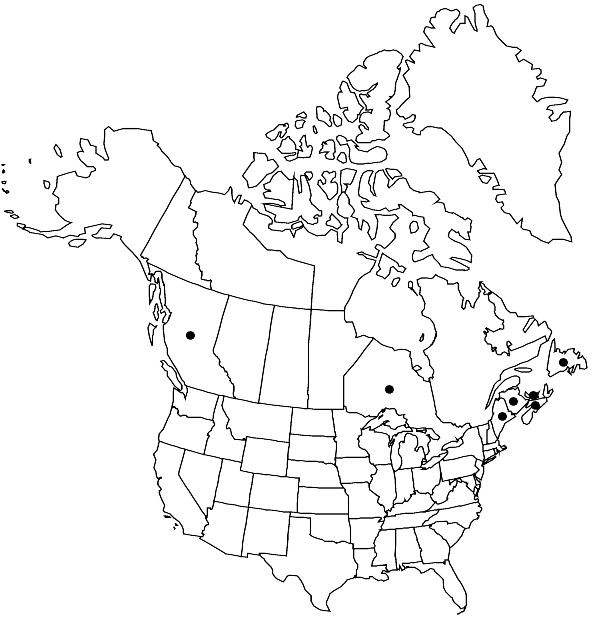Difference between revisions of "Atrichum undulatum"
Prodr. Aethéogam., 42. 1805,.
FNA>Volume Importer |
imported>Volume Importer |
||
| (4 intermediate revisions by 2 users not shown) | |||
| Line 9: | Line 9: | ||
|name=Polytrichum undulatum | |name=Polytrichum undulatum | ||
|authority=Hedwig | |authority=Hedwig | ||
| + | |rank=species | ||
|publication_title=Sp. Musc. Frond., | |publication_title=Sp. Musc. Frond., | ||
|publication_place=98. 1801 | |publication_place=98. 1801 | ||
| Line 27: | Line 28: | ||
|elevation=usually low elevations | |elevation=usually low elevations | ||
|distribution=B.C.;N.B.;Nfld. and Labr. (Nfld.);N.S.;Ont.;P.E.I.;Maine;Europe;w;c Asia;n Africa. | |distribution=B.C.;N.B.;Nfld. and Labr. (Nfld.);N.S.;Ont.;P.E.I.;Maine;Europe;w;c Asia;n Africa. | ||
| + | |introduced=true | ||
|discussion=<p>No <i>Atrichum</i> species occurring in North America has been as widely misunderstood as <i>A. undulatum</i>. Evidently introduced from Europe, its weedy habitat and strongly arcuate, almost horizontal capsules are the surest means of recognition. Variety minus, a fixture of European manuals, is a stunted form that is highly variable and possibly a hybrid. Its occurrence in North America has not been demonstrated. As used by American authors (e.g., O. E. Jennings 1951), it probably refers to <i>A. altecristatum</i>.</p> | |discussion=<p>No <i>Atrichum</i> species occurring in North America has been as widely misunderstood as <i>A. undulatum</i>. Evidently introduced from Europe, its weedy habitat and strongly arcuate, almost horizontal capsules are the surest means of recognition. Variety minus, a fixture of European manuals, is a stunted form that is highly variable and possibly a hybrid. Its occurrence in North America has not been demonstrated. As used by American authors (e.g., O. E. Jennings 1951), it probably refers to <i>A. altecristatum</i>.</p> | ||
|tables= | |tables= | ||
| Line 36: | Line 38: | ||
-->{{#Taxon: | -->{{#Taxon: | ||
name=Atrichum undulatum | name=Atrichum undulatum | ||
| − | |||
|authority=(Hedwig) P. Beauvois | |authority=(Hedwig) P. Beauvois | ||
|rank=species | |rank=species | ||
| Line 52: | Line 53: | ||
|publication year= | |publication year= | ||
|special status= | |special status= | ||
| − | |source xml=https:// | + | |source xml=https://bitbucket.org/aafc-mbb/fna-data-curation/src/2e0870ddd59836b60bcf96646a41e87ea5a5943a/coarse_grained_fna_xml/V27/V27_191.xml |
|genus=Atrichum | |genus=Atrichum | ||
|species=Atrichum undulatum | |species=Atrichum undulatum | ||
Latest revision as of 22:24, 5 November 2020
Plants small to fairly large, dark green. Stems 2–5 cm. Leaves sparse below, more crowded above, 4–9 × 0.8–1.5 mm, lingulate to lanceolate, undulate, keeled distally, concave to flat proximally, with oblique rows of abaxial teeth on undulations, the apex acute; costa percurrent, with teeth on abaxial surface in distal half; lamellae 2–6, 2–4(–7) cells high; median leaf cells 20–32 µm wide, irregularly angled to hexagonal, sometimes rounded, often transversely elongate, convex on both surfaces, smooth or with minute, verrucose or striate papillae on abaxial surface, walls firm, strongly collenchymatous with trigones. Sexual condition polygamous, some shoots bisexual, others apparently male or female; perigonial bracts broad, forming antheridial buds, often several buds per plant. Seta 1(–3) per perichaetium, 1–3 cm, reddish brown. Capsule 2–4(–8) × 0.5–1 mm, curved to distinctly arcuate, almost horizontal; operculum 2–3 mm. Spores (12–)16–28 µm.
Phenology: Capsules mature spring–summer (Apr- Jul).
Habitat: Soil, dry weedy habitats, especially roadside ditches
Elevation: usually low elevations
Distribution

Introduced; B.C., N.B., Nfld. and Labr. (Nfld.), N.S., Ont., P.E.I., Maine, Europe, w, c Asia, n Africa.
Discussion
No Atrichum species occurring in North America has been as widely misunderstood as A. undulatum. Evidently introduced from Europe, its weedy habitat and strongly arcuate, almost horizontal capsules are the surest means of recognition. Variety minus, a fixture of European manuals, is a stunted form that is highly variable and possibly a hybrid. Its occurrence in North America has not been demonstrated. As used by American authors (e.g., O. E. Jennings 1951), it probably refers to A. altecristatum.
Selected References
None.